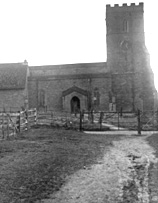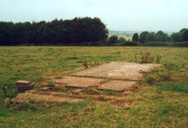 |

"Windy Ridge" was the name for Church Hill in Whaddon. Church Hill stands to the south of Whaddon Church. If you ever visit there you will see why soldiers working there gave it is nickname.
These days the field is occupied by a few cows. But during World War Two it was used to receive and transmit signals to British forces, British agents, and other combatant forces.
At Windy Ridge stood two radio huts. One hut was used for teleprinting and the other was used for radio operation. In addition to this the field contained a large number of radio attennae. All that remains of these buildings are two concrete bases.
Church Whaddon
Soldiers assigned to work as radio operators at Windy Ridge were selected on the basis that they could send and receive morse code messages at a rate of at least 22 words per minute. More importantly, the messages they sent and received had to turned into/from morse code very accurately. A mistake of a single letter could cost lives.
The Radio Operators worked a two-shift system. This meant that they either worked from 08:00 to 16:00 or 16:00 to 22:00. Hand-written sheets of encoded messages would be passed from the Teleprinter hut to the Radio Operations hut. Here the Radio Operators would tap out the messages. They did not know what

The messages to allied command for "Operation Overlord" , the D-Day Landings were sent from Windy Ridge. Another special "radio conversation" was sent from Windy Ridge. One operator was commanded to send a "call-sign" repeatidly for over two-hours. When he finally received a reply, his Sargent gave him a special message sheet to send. When the message was finished he was told that the message contained the terms for the surrender of the German forces who occupied the Island of Jersey.
Life could be difficult for the Radio Operators, every messages that they sent would be checked for accuracy by someone listening to the transmission. If the person checking felt that they had been too many mistakes then the Radio Operator would be instructed to send the message again. In some circumstances the instruction would be received that a new operator should send the message. Sometimes, the operator in question would wait a couple of minutes and send the message again. This usually worked. But on one occasion it didn't, in frustration the Operator added a coded insult to the person checking the message. As a result he was given 7 days confined to barracks. The barracks in this case being at Tattenhoe.
